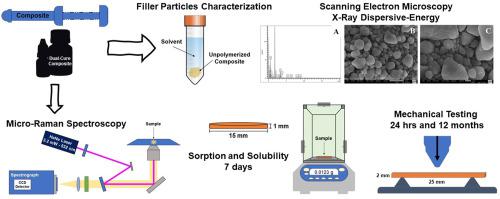Journal of the Mechanical Behavior of Biomedical Materials ( IF 3.3 ) Pub Date : 2020-12-27 , DOI: 10.1016/j.jmbbm.2020.104288 Vitaliano Gomes de Araújo-Neto , Maicon Sebold , Eduardo Fernandes de Castro , Victor Pinheiro Feitosa , Marcelo Giannini

|
Objective
This study evaluated physical and mechanical properties and characterized the filler particles of seven composites.
Materials and methods
Filtek Supreme (FS, 3M Oral Care), Forma (FO, Ultradent), Charisma Diamond (CD, Kulzer), Spectra Smart (SS, Dentsply), Filtek Bulk Fill (FB, 3M Oral Care), Tetric N-Ceram Bulk Fill (TB, Ivoclar), and Cention N (Ivoclar) in self- (CNSC) or dual-curing (CNDC) were evaluated. Fillers size, shape, and content were analyzed by scanning electron microscopy (SEM) and X-ray dispersive energy spectroscopy (EDX). Disk-shaped specimens (n = 5) were prepared for sorption (SP) and solubility (SL). Flexural strength and elastic modulus were tested at 24 h and 12 months (n = 10). Degree of conversion (DC%) and maximum rate of polymerization (Rpmax) were evaluated using micro-Raman spectroscopy. SP and SL results were submitted to Kruskal-Wallis one-way ANOVA and Dunn's pairwise test (α = 0.05). Mechanical properties were analyzed by 2-way ANOVA and Tukey's test (α = 0.05). DC% of CNSC and CNDC was compared by independent t-test (α = 0.05). Rpmax results were analyzed by 1-way ANOVA and Tukey's test (α = 0.05).
Results
The composites differed regarding filler size, shape, and content. CD and CNSC showed lower SP than FS. SS had lower SL than CNSC and CNDC. CNDC presented higher DC% than CNSC. CD, TB, and CNDC showed the highest Rpmax. TB, CNSC, and CNDC showed the lowest 24-h flexural strengths. Mechanical properties of CD did not decrease, while FO, TB, and CNSC showed a significant reduction after storage.
Conclusions
Monomer composition and fillers characteristics greatly influenced the physico-mechanical properties of the tested composites.
中文翻译:

评估常规,散装和生物活性树脂基复合材料的物理机械性能和填料颗粒表征
目的
这项研究评估了物理和机械性能,并表征了七种复合材料的填料颗粒。
材料和方法
Filtek Supreme(FS,3M口腔护理),Forma(FO,Ultradent),Charisma Diamond(CD,Kulzer),Spectra Smart(SS,Dentsply),Filtek散装(FB,3M口腔护理),Tetric N-Ceram散装(TB,Ivoclar)和Cention N(Ivoclar)在自我(CNSC)或双重固化(CNDC)中进行了评估。通过扫描电子显微镜(SEM)和X射线色散能谱(EDX)分析填料的尺寸,形状和含量。制备了用于吸附(SP)和溶解度(SL)的盘状样品(n = 5)。在24小时和12个月(n = 10)时测试了弯曲强度和弹性模量。转化度(DC%)和最大聚合速率(Rp max)使用显微拉曼光谱法进行评估。SP和SL结果已提交给Kruskal-Wallis单向方差分析和Dunn成对检验(α= 0.05)。力学性能通过2通ANOVA和Tukey检验(α= 0.05)进行分析。通过独立的t检验比较CNSC和CNDC的DC%(α= 0.05)。Rp max结果通过1向ANOVA和Tukey检验(α= 0.05)进行分析。
结果
复合材料在填料尺寸,形状和含量方面有所不同。CD和CNSC显示SP低于FS。SS的SL低于CNSC和CNDC。CNDC的DC%高于CNSC。CD,TB和CNDC显示最高的Rp max。TB,CNSC和CNDC的24小时抗弯强度最低。CD的机械性能没有降低,而FO,TB和CNSC在储存后显示出明显的降低。
结论
单体组成和填料特性极大地影响了测试复合材料的物理机械性能。











































 京公网安备 11010802027423号
京公网安备 11010802027423号